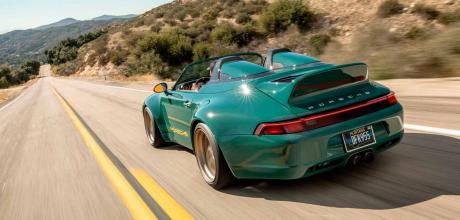2022 Gunther Werks Speedster Porsche 911 4.0 993
Gunther Werks presents its second creation based on Porsche’s 993, the Speedster – so what’s it like? Written by Kyle Fortune. Photography by Ted7.
REIMAGINED 993 SPEEDSTER
First drive in Gunther Werks’ stunning air-cooled open-top
Gunther Werks Speedster
We’re back with Gunther Werks to sample an open-topped variant of its reimagined 993-generation Porsche 911s
We begin with coffee in Starbucks off Highway I-10 at Desert Hills Premium Outlets, Palm Springs. It’s out of necessity rather than choice – I’m here for the wi-fi, not the burnt, bitter, black coffee. Like many others whose names are shouted out by the baristas, I’m killing time before ‘work’ starts, though unlike most of them, I can’t wait to get going. There’s a transporter heading this way, and in the back is Gunther Werks’ new Speedster. Not a bad day at the office, then.
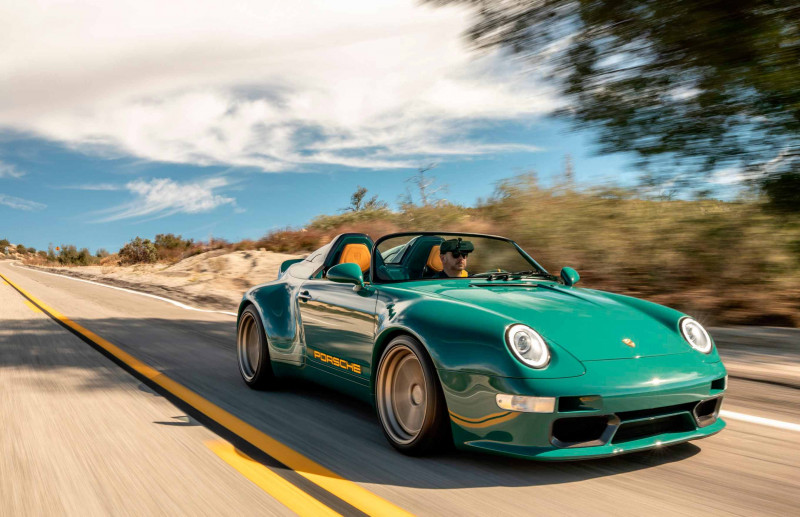
A quick recap in the unlikely event that Gunther Werks has passed you by. Based in Huntington Beach, California, Peter Nam’s company takes 993s and applies current engineering methods, materials and expertise to them. Think of it as a continuation; the idea being to project the 993’s timeline to today, as if Porsche was still building air-cooled 911s and injecting them with some GT3 and RS DNA.
DrivesToday has followed the company’s journey since its earliest days, finding a Facebook post on a 993 group back in 2017 showing a headlight design that piqued our interest. That eventually led to the world’s first drive in the 400R – the Gunther Werks 993 Coupe prototype – back in. More recently, we revisited the Gunther Werks Coupe, discovering what four years of obsessive development has created for 25 lucky customers. In short, it’s an incredible car that lives up to the company’s aim of building the world’s best 993.
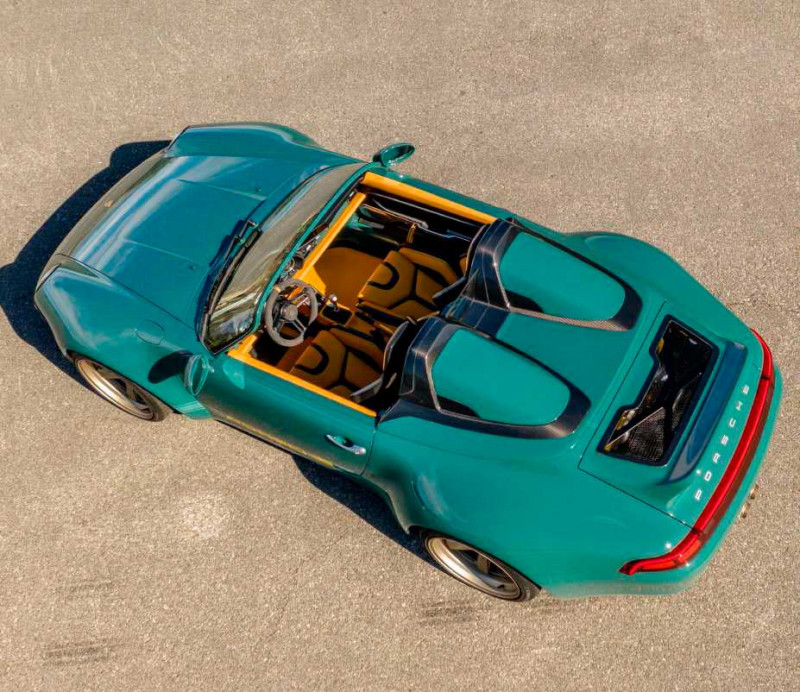
Gunther Werks said it would only build 25 Coupes and, despite plenty of requests from eager buyers for more, it’s stuck to that tiny production number. Nam did concede back in 2017 that he had ‘ideas’ for other models, and in August 2021 the Speedster was first revealed at Quail, as part of Monterey Car Week. Like the Coupe, the Speedster will be limited to a build of just 25 cars, with production ramping up in 2022 as the final Coupes are delivered. Like the 400R that became the Coupe, DrivesToday is the first to drive the Speedster prototype that’s heading down the I-10 while I regret my poor coffee choice.
Forget what you’ve heard about American roads. I spent my youth convinced the country was crisscrossed by grid-pattern routes, but even America’s can-do attitude must concede to topography at times. Around the mall and its expansive car park is exactly the sort of easy, unimaginative road layouts that could be laid out by an Etch a Sketch, but off that, heading west from nearby Banning, is the SR-243. This road scales Mount San Jacinto and the State Park, joining up with the Palm to Pines road on Route 74.
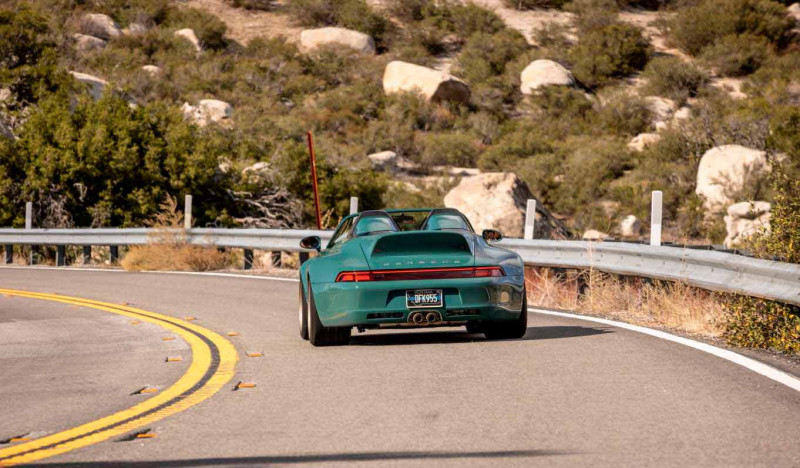
These roads are so good that Porsche used them on the 997 GTS launch. It’s a mix of every conceivable bend, camber, crest, compression and anything else that’s tricky – and fun. As brilliant as that is, it’s quiet, too, with the certainty being of next to no traffic. Driving nirvana, then, and we’ve the promise of quite the car to enjoy it.
Having spent some time in the Coupe a few days earlier and seen the Speedster at Gunther Werks HQ at the same time, anticipation is high. Yet as the Speedster rolls out of the transporter in the car park, it’s difficult not to be blown away by the execution all over again. Like the Coupe, the Speedster’s body is constructed from carbon fibre, painted in Cannes green with yellow Porsche scripting on its flanks matching the yellow leather highlights inside. That’s yellow like the solid lines I shouldn’t cross while I explore Route 243 in it later, with amber orange tones like Porsche’s Bahama yellow, rather the brightness of, say, Speed yellow. And it works very well indeed.
Naturally, you can pick whatever colours you want, inside and out. You can even specify a naked carbon Speedster.
Doing so adds a not-insignificant cost to your Speedster: naked carbon takes significantly longer than a painted carbon body because of the need to exactly match the weave along all its joins.
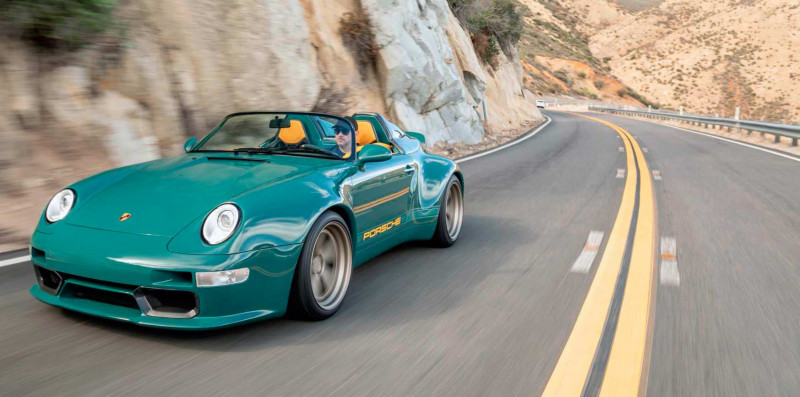
Not that any increase in price is likely to concern buyers, but the added wait might. Pricing is similar to the Coupe, so there’s a starting price of $675,000 but think usefully north of $850,000 with a few choice options. That number has done little to quell demand. Indeed, before a single production model has been built, Gunther Werks has sold them all. So if you’re reading this thinking, “Yes please!” you’re too late.
Gunther Werks employs the same talented team that built the Coupe to create its Speedster, so it’s no surprise that the flat six out the back is the same specification. No bad thing, either: Rothsport Racing’s Jeff Gamroth builds the 4.0-litre air-cooled engine and it’s a masterpiece. It uses an original casing but everything else is custom, with billet barrels and a crank that rotates forged conrods topped by unique Mahle pistons. There are equal length stainless steel headers, coil-on-plug ignition and a GT3 plenum, while the fuel injection system and throttle bodies are his own design. Controlling all that is a Motec engine management system with a bespoke tune, while the exhaust is a valved lightweight setup with a Sport Mode that ups the tempo and switches the map for even greater response.
“The Speedster is able to deliver a torsional figure that’s 50 per cent stiffer than a stock 993 Coupe”
Like Porsche itself, Gunther Werks quotes its figures conservatively, simply stating a 400+hp output, but the reality is you can add about 30hp to that. That peak power is produced at 7,800rpm, where the red paint on the white rev-counter starts, with maximum torque of 447Nm coming in a bit earlier at around 6,500rpm. For an air-cooled engine punching out in excess of 100hp per litre it’s remarkably civilised, idling steadily and quietly. It feels so immediate and crisp in its response, and so lacking in internal inertia, that it’s impossible to resist the temptation to give the accelerator exploratory blips after starting it. The reward for doing so is an immediate, rousing flare of revs that’s racer quick but road-car civilised. You’ll need some revs heading off, with a light flywheel if you’re not judicious with the clutch, because it’s easy to stall. Keep that in mind and it’s easy enough – this demand alone underlining that for all the Speedster’s obvious beauty, at its heart it remains very much a driver’s car.
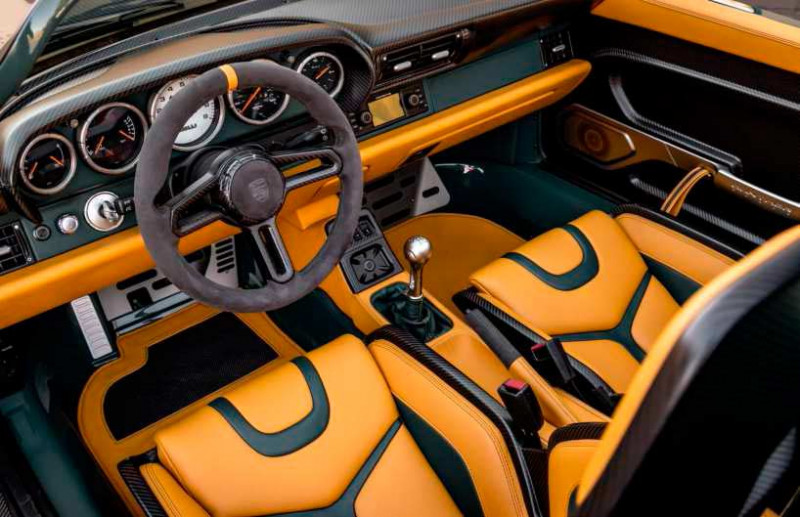
Like the Coupe, there are a few compromises. Arguably necessary ones, given Gunther Werk’s goals with the car, but they’re factors that need consideration. Most obviously is the turning circle: the significantly widened front axle has 11-inch wide front wheels, with a 295/30/18 tyre. Unlike the Pirelli P-Zero Corsas of the Coupe, Gunther Werks has specified a Continental Extreme Contact Sport tyre on the Speedster, choosing these over the Pirellis because there’s both greater potential supply and slightly softer sidewalls, which are beneficial to the ride quality and suit the Speedster’s character better. It’s tested these tyres on the Coupe and found them to be beneficial there, too. The rear wheels are 13-inches wide, with a 335/30/18 tyre.
The Speedster prototype here rides on a conventional five-lug hub with 18-inch Gunther Werks T-6061 forged aluminium three-piece wheels, although there’s the option to specify it with a set of lighter centre-lock forged magnesium wheels with Dymag carbon-fibre barrels. This would drop the wheel weight by around half, to a little over 7kg in each corner.
Behind the standard or optional wheels are Brembo GT six-piston callipers grabbing a 335x32mm slotted front disc, with the rear axle featuring a four-piston Brembo GT calliper with 345x28mm slotted disc. Those hang off a suspension setup specified by Gunther Werk’s chassis expert Cary Eisenlohr, of Eisenlohr Racing Products. The standard setup features a bespoke KW coilover system, but the prototype is running the optional JRZ electronic setup that everyone specifies, with the system monitoring the dampers 1,000 times a second to provide the best response. Naturally, there are differing setups – be it the default, Comfort or Sport – although each setting will maximise comfort and make adjustments when it senses it’s required. It’s controlled by an app on a smartphone, which feels a touch unnecessary. A simple dial, like the one Gunther Werks makes for the lights, with those three settings would arguably suit the analogue, old-school appeal of the Speedster better.
While the turning circle is a consideration at slower speeds in tighter spaces, it’s not an issue on the road. Here the steering is wonderfully communicative. That wide front axle and the not-inconsiderable contact patch on the road produces huge stability and confidence when turning in. There’s a quickness to the nose that’s agile without being too ‘darty’, the weighting of the steering is nicely judged, and the feel through the Gunther Werks carbon-fibre hollow Sport Design Edition steering wheel is spot on.
The wheel itself is fantastic to hold: the thumb recesses above the spokes are perfectly positioned, and its girth, while visually giving the impression of thickness, doesn’t feel like it in your hands. Instead, it conveys a light and thinness that’s entirely in keeping with the intent of delivering sensation. Indeed, the whole interior is a tactile delight.
It’s a fine mix of leather, matte carbon fibre, metal and paint – an example of Gunther Werks building on, rather than robbing the Speedster of its classic 993 character, which is a neat trick to pull off. If I’m splitting hairs, and I were one of the 25 buyers, I’d perhaps ask for a more discreet solution for the housing of the sport button for the exhaust. Its prominence fore of the gearstick isn’t helped by the slightly lacklustre button itself. I’d also want a simpler, thinner, bezel around the dials. These are tiny details, of course, and ones that I’ve no doubt Gunther Werks would happily revise should it be required. And that’s an enormous part of the Speedster’s appeal. Each car is individually specified and will be unique to its owner, thanks to Gunther Werks having a commissioning suite at its Huntington Beach HQ.
Yet for all its configurability and fine execution, at its core Gunther Werks has always been committed to the cause of providing an engaging driver’s car. Being a Speedster helps; there’s no weather protection, so the steeper raked carbon-fibre windscreen surround with its screen from a 964 Speedster lacks any means of having a hood, however rudimentary, attached to it. Similarly, there are no side windows, though the fitment of a small piece of glass between the double-bubble humps behind the passenger and driver’s heads does keep the cabin remarkably draught-free at speeds that are the right side of legal. Above that, I couldn’t possibly say, but I’d imagine it’d be absolutely fine deep into three figures.
The 993 Cabriolet’s underpinnings might have been commendably stiff three decades ago, but drive one now and you’ll realise how far things have come. Any concerns that the structure might reveal compromises, particularly given the focus of the suspension, are answered by Gunther Werks’ extensive work on strengthening the platform. To do so the team sought out the skills of Trevor Harris. The race engineer has an incredible CV covering car design for every discipline, from Pikes Peak racers to F1 and Can-Am cars. With his input the Speedster is able to deliver a torsional figure that’s 50 per cent stiffer than a stock 993 Coupe. Numerous elements assist here, including the double-skinned sills, and a frame and rollover protection bar filling the void behind the rear seats. What makes that all doubly impressive is the fact that the Speedster weighs 45kg less than the Coupe, with a kerbweight of 1,156kg. That’s without the optional lightweight wheels, which would reduce the weight further.
That stiffness is obvious by the wheel and body control on offer when driven hard on the route above Palm Springs. Here the Speedster’s taut responses feel contemporary rather than compromised, creating an appealing mix of analogue thrills, sound and feedback with a composure that’s deeply impressive. With the noise of the flat six reverberating around the hills as it’s repeatedly and enjoyably wrung out to its redline, the sounds emanating from it are as intoxicating as the physical forces it creates. The pedal spacing is nicely judged for my size nines, the brake pedal’s reassuring firmness and huge retardation giving a solid platform to blip the throttle for downshifts, with the gearstick being precise through its lengthy movement. A shorter travel would up the ante: the gearstick’s movement is long as opposed to longwinded, so if a bit could be removed it’d suit the ferocity and immediacy of the engine’s response just that little bit better.
Regardless, as a whole it’s difficult not to be blown away – again – by Gunther Werks. The Speedster is every bit as engaging as the Coupe, only more so. It’s compromised as a result, but that’s something to be celebrated. It’s elemental, with the experience of being open adding so much more to the drive, though, admittedly, limiting the opportunities to use it. Speedsters are always special, occasional-use cars, and the Gunther Werks is no exception. Its mix of classic connectivity, feel and compactness, with huge air-cooled character and contemporary performance is incredibly compelling, and pretty much unique among cars you can buy today.
LIKES
- Greater level of connectivity; visceral and aural thrills thanks to the open top
- Impressively stiff platform, agile handling with fine control
- Old-school character, modern build quality, and an engine that needs to be experienced to be believed
DISLIKES
- Gearshift would benefit from being a touch shorter in its throw
- Some of the interior buttons fall slightly short of expectations and a button for suspension modes would be preferable to a phone app
- Turning circle needs management in tight spaces
TECHNICAL DATA FILE Gunther Werks Speedster
- Year 2022
- Engine Capacity 4.0 litres
- Compression ratio 11.0:1
- Engine spec Air-cooled 4.0L RS crank, custom Mahle pistons, custom forged conrods, twin plug, coil ignition, individual throttle bodies with high flow injectors, Motec ECU running dual-switchable maps, double oil coolers, GT3-style carbon plenum, lightweight Li-ion battery
- Maximum power 430bhp at 7,800rpm
- Maximum torque 427Nm at 6,500rpm
- Transmission Six-speed G50 manual gearbox with bespoke ratios, a singlemass flywheel, uprated singleplate clutch and a carbon clutch differential with 40 per cent locking
- Suspension Front Bespoke specification JRZ electronically controlled remote reservoir damped suspension with hydraulic nose lift, lightweight RS spec uprights, ball-jointed and solid mounted throughout with adjustable tie rods and a front strut brace
- Rear Bespoke specification JRZ electronically controlled remote reservoir damped suspension, ball-jointed and solid mounted throughout with adjustable tie rods
- Wheels & tyres Front 11x18-inch; 295/30/18 Rear 13x18-inch; 335/30/18
- Dimensions Width 1,911mm
- Weight 1,256kg unladen
- Performance 0-62mph Not tested
- Top speed Not tested
ABOVE The Speedster will produce well over 400bhp at around 7,800rpm
ABOVE All-new 3D-printed Inconel tips feature on the twin exhausts
BELOW There’s storage space behind the driver and passenger, accessed via lockable lids
BELOW The cabin remains draught-free, thanks in part to a glass screen between the humps behind the passenger and driver’s heads
ABOVE The cabin has been given a modern overhaul though it remains recongisable to the 993 era it hails from
ABOVE All-new 3D-printed Inconel tips feature on the twin exhausts


